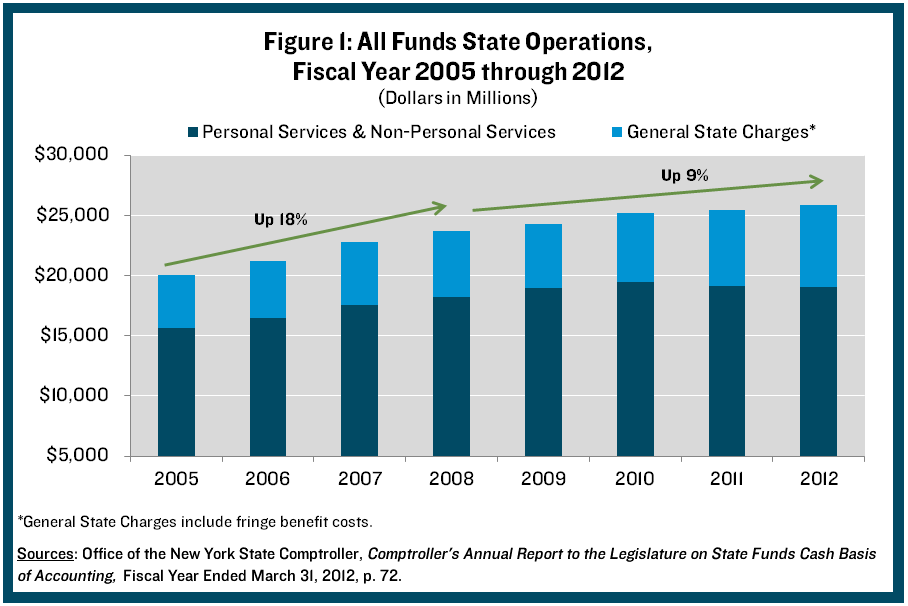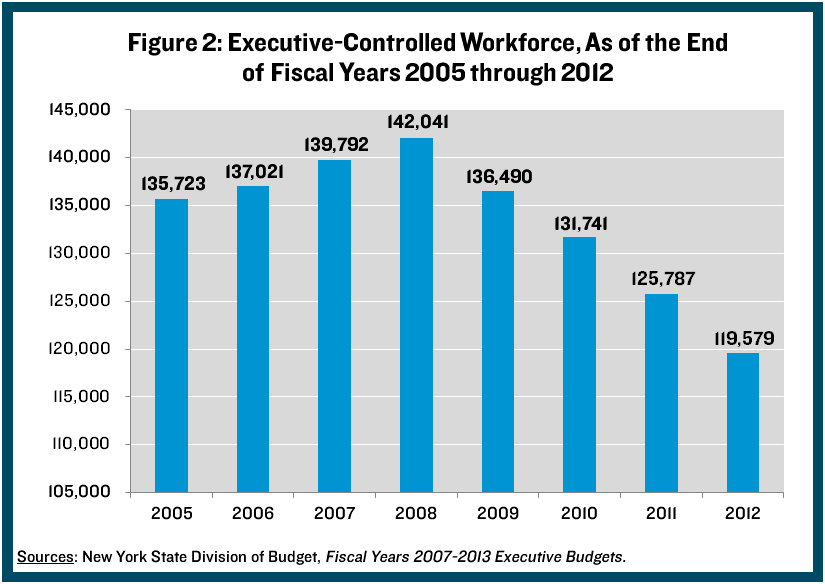Little Noticed but Significant: The Sound Recommendations of the SAGE Commission
On February 12th the Spending and Government Efficiency Commission, or “SAGE” Commission, submitted its final report to Governor Andrew Cuomo. With most state leaders and observers focused on budget negotiations, this comprehensive report on streamlining and modernizing State government was largely overlooked. But it deserves attention, and its many worthwhile recommendations should be implemented.
The painstaking work of government redesign is the only way to continue the progress toward more fiscally sustainable government that has begun during the Cuomo administration. Before the fiscal crisis began in 2008 State spending on operations was rising rapidly increasing by 18% in just three years from 2005 to 2008. (See Figure 1.)1 Since then, due to agency budget reductions and implementation of some preliminary SAGE recommendations issued in 2011, total growth in total State operations spending from 2008 to 2012 was cut in half to 9%.2 Most recently from fiscal year 2010 to fiscal year 2012, agency spending has been held flat at about $19 billion per year.
Headcount figures for personnel under direct control of the Governor (the Executive headcount, not including the judiciary or the legislature) tell an even more dramatic story of State agencies doing more with less. At the end of fiscal year 2005 the Executive headcount was 135,723. (See Figure 2.) By the end of fiscal year 2012 the figure had dropped to 119,579, a decrease of 16,144 staffers or 12%. From the peak hiring year of fiscal year 2008 the drop was even more marked; Executive headcount from the end of 2008 fell from 142,041 to its current level, shrinking by 22,462 positions or 17%.
To continue progressing toward a sustainable and effective state government, the SAGE Commission makes recommendations to reorganize state agencies, reduce costs and improve service, and build a culture of performance and accountability. Among the most important plans and proposals are:
- “Right size” the expensive and underutilized criminal and juvenile justice systems by closing facilities. Four prisons have been closed and closure of two more was authorized in the 2013-14 budget. More can and should be done and the same approach should be taken with respect to empty or near-empty state-run juvenile institutions. Unfortunately the legislature rejected the Governor’s proposed expansion of the “Close to Home” program for juvenile offenders that would move them to programs in the communities where their families live.
- Restructure services for the mentally ill and developmentally disabled. The most recent scandal – concerning the exorbitant Medicaid charges the State passed on to the federal government for services provided in these facilities and elsewhere in the system – should be the final nail in the coffin for this antiquated and problematic system of care. Newly approved federal funds awarded to New York from the “Balanced Incentive Program” can be used to create placements tailored to individual needs and integrated in communities.
- Merge and consolidate agencies and public authorities that perform overlapping functions to achieve recurring savings. For example, the merger of the Civil Service Department and the Office of Employee Relations proposed in the Executive Budget but rejected by the legislature should be reinvigorated. The effort to combine activities like fleet management, printing, and lab operations across all state agencies may encounter opposition from those with a vested interest in maintaining jobs, but it can achieve long lasting savings and must be pursued.
- Take full advantage of modern information technology to improve customer service, e.g. by electronically enabling licensing and permitting. This will make cost reductions and better customer service possible.
- Reform the civil service law and the performance appraisal process to enhance managerial discretion in employment decisions. This will be critical to managing reduced resources effectively; discussions with the legislature should begin immediately.
- Expand design-build authority for capital projects to all State agencies to reduce construction costs. Design-build allows private contractors to bid on an entire project rather than on a pre-existing design. Although the new Tappan Zee bridge project is employing a design-build model and Governor Cuomo sought the authority in the budget to extend the practice, the legislature rejected it. With New York approaching its statutory debt cap, measures that reduce capital costs are critical. The legislature should reconsider and approve the expansion of design-build and other public-private models that have been successfully used in other jurisdictions.
Perhaps the most important, potentially transformative recommendations made by the Commission are in the section of the report devoted to agency performance management initiatives entitled NY Performs.
The preliminary recommendations made by the SAGE Commission in December 2011 identified 16 pilot agencies for the initial development of performance management systems with the goal of bringing all State agencies onboard by June 2012 under a coordinating unit within the Division of Budget or the Governor’s office. The final SAGE report indicates a small group of management staff has been selected to oversee the initiative, but it has taken more time than originally anticipated to implement the system. The Commission took the positive step of expanding the effort to include public authorities. The new goal for full participation is December 2013.
New York has long been woefully behind in measuring performance so that taxpayers can answer the questions: “what does my state government do and how much does it cost?” The design of NY Performs is based on best practices employed elsewhere, notably in Washington and Virginia. The plan is to develop results-oriented metrics for state agency functions and make them available to the public. The ‘screen shots’ of illustrative performance metrics in the SAGE report are encouraging. The sample from the Office of Temporary & Disability Assistance, for example, includes 1) a description of the agency mission and goals as well as its scope of operations; 2) a set of key performance indicators; 3) a section that details strategic initiatives being pursued to improve performance; and 4) background facts that provide a context for judging agency operations. Other sample screenshots provided for the Office of Tax and Finance and the Department of Motor Vehicles show the system will also report on projects, milestones, and performance indicators for each strategic initiative, and that the public user will be able to drill down on each performance indicator to see an explanation of the selected performance target. As these metrics are developed and refined a high priority should be placed on outcome and efficiency, not simply process measures. Comparative benchmarks should be established and time periods and reporting intervals should be made uniform.
A noteworthy aspect of NY Performs is the emphasis on cross-agency efforts. The SAGE report highlights data “dashboards” in development for strategic priorities such as the Medicaid Redesign Team. Pulling agencies out of their traditional silos in order to focus on common goals is the most advanced form of performance management, with the potential to produce significant results for the public.3
In order to do more with less the basic business functions of state government must be reengineered. The easier, more well-travelled path is to cut with a blunt instrument while waiting for the budget climate to improve so spending can rise again. The SAGE Commission recommendations offer a far superior alternative, one to which State leaders, and in particular the State Legislature, should commit.
Footnotes
- Excluding fringe benefits the increase during that time period was 16%.
- Excluding fringe benefits the growth rate was just 4%.
- The ultimate achievement in performance management is the integration of NY Performs with the state budget. The budgets of the 16 pilot agencies that have performance management metrics development underway should be reorganized to align more closely with agency goals and the programs intended to achieve them. After budgets are moved into programmatic format the new cost categories can be matched with performance indicators to form the basis for determining unit costs for services.

